University Financial Planning Report: Ashleigh's Financial Position
VerifiedAdded on 2022/08/26
|8
|1453
|19
Report
AI Summary
This report provides a financial planning analysis for Ashleigh, a nursing supervisor, aiming to improve her overall financial position. It focuses on key areas including superannuation, tax planning, and budget planning. The discussion covers different types of superannuation funds, their advantages, and potential drawbacks, emphasizing the importance of combining investments for tax efficiency. Tax planning strategies are outlined to minimize taxable income and maximize tax relief, while budget planning is presented as a crucial tool for conscious fund allocation and tracking income. The report recommends strategies to enhance Ashleigh's financial statements, offering recommendations on superannuation investment, tax planning, and budget planning to strengthen her financial position and achieve her financial goals. The report references key financial planning concepts and strategies and provides insights to enhance the financial well-being of individuals.
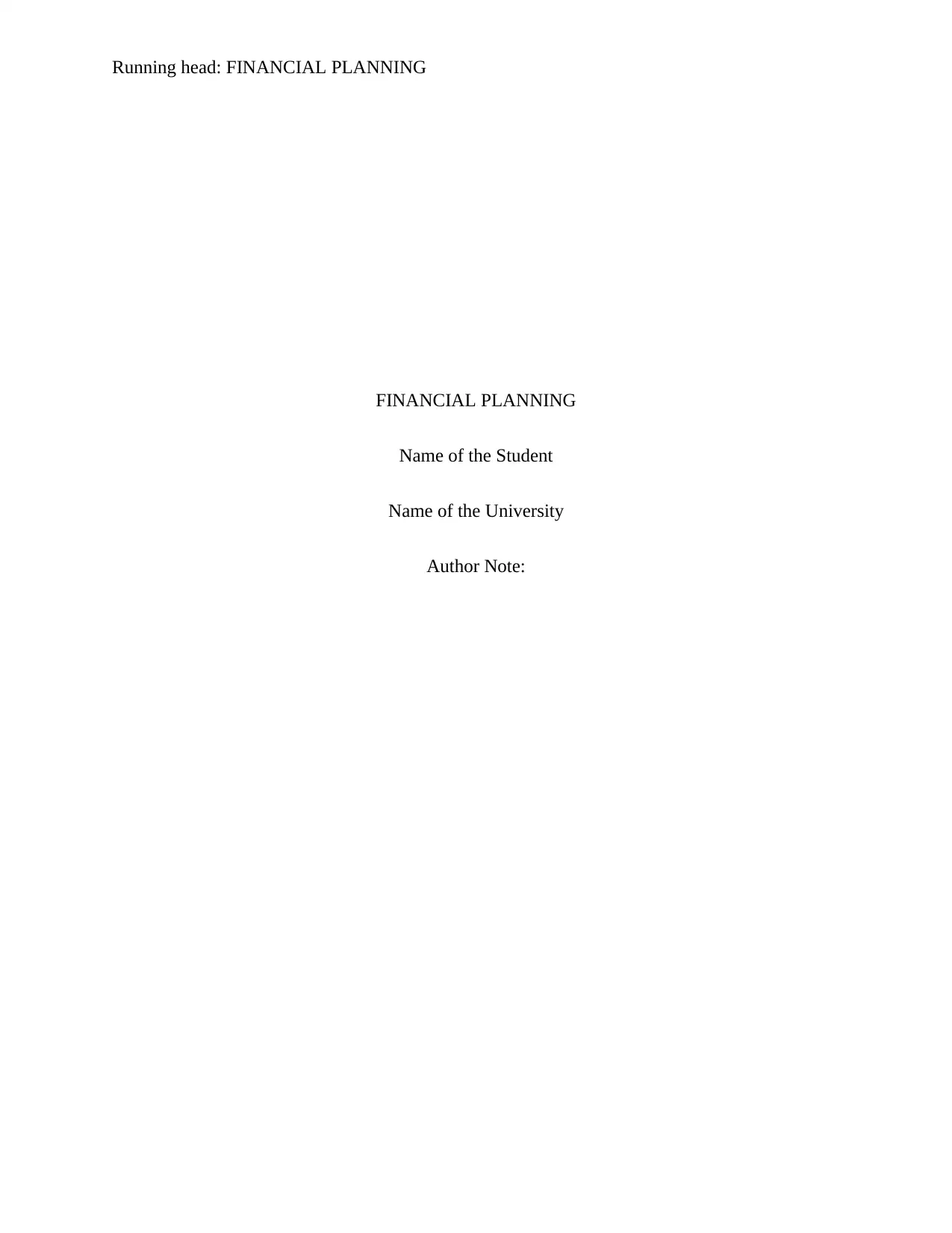
Running head: FINANCIAL PLANNING
FINANCIAL PLANNING
Name of the Student
Name of the University
Author Note:
FINANCIAL PLANNING
Name of the Student
Name of the University
Author Note:
Paraphrase This Document
Need a fresh take? Get an instant paraphrase of this document with our AI Paraphraser
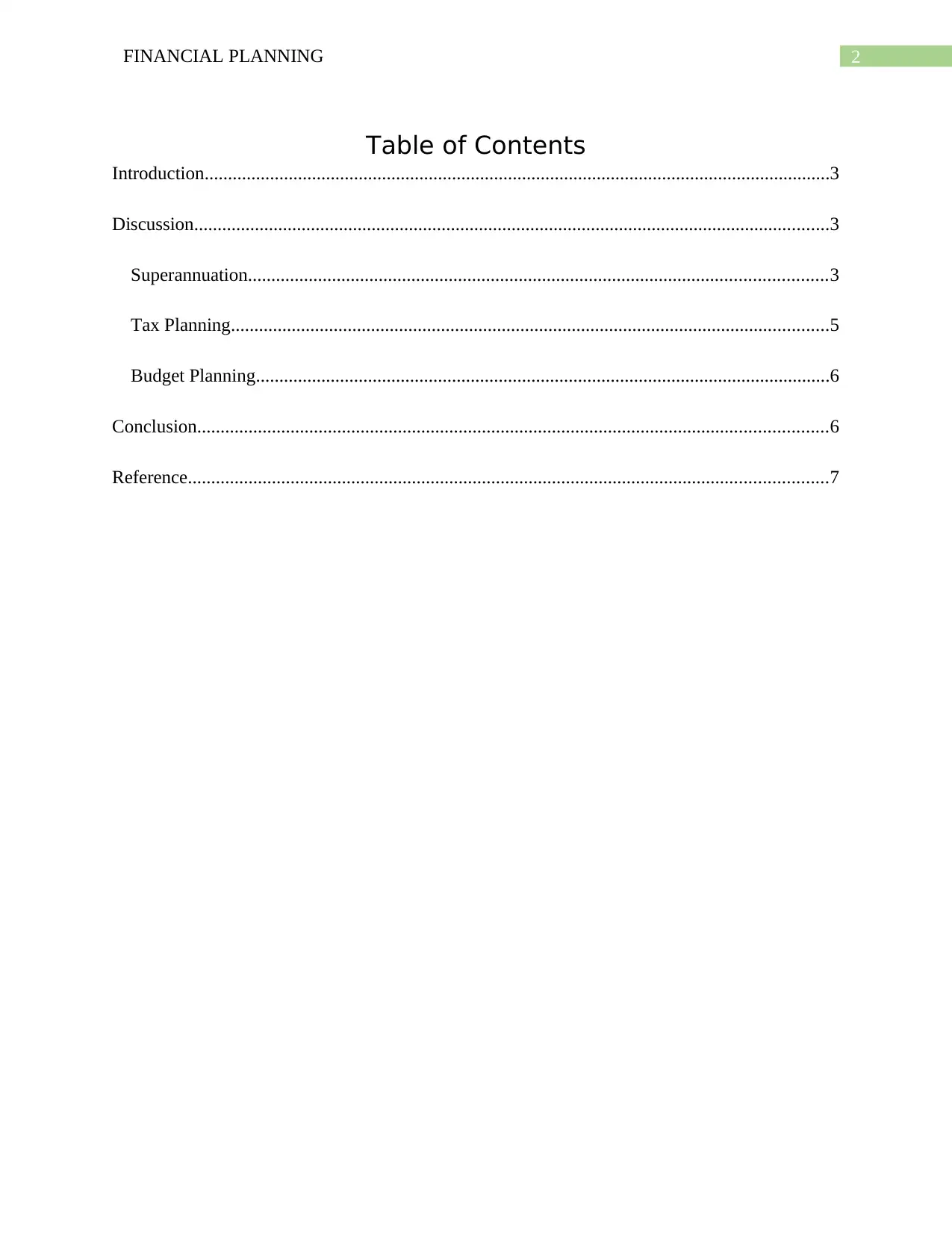
2FINANCIAL PLANNING
Table of Contents
Introduction......................................................................................................................................3
Discussion........................................................................................................................................3
Superannuation............................................................................................................................3
Tax Planning................................................................................................................................5
Budget Planning...........................................................................................................................6
Conclusion.......................................................................................................................................6
Reference.........................................................................................................................................7
Table of Contents
Introduction......................................................................................................................................3
Discussion........................................................................................................................................3
Superannuation............................................................................................................................3
Tax Planning................................................................................................................................5
Budget Planning...........................................................................................................................6
Conclusion.......................................................................................................................................6
Reference.........................................................................................................................................7
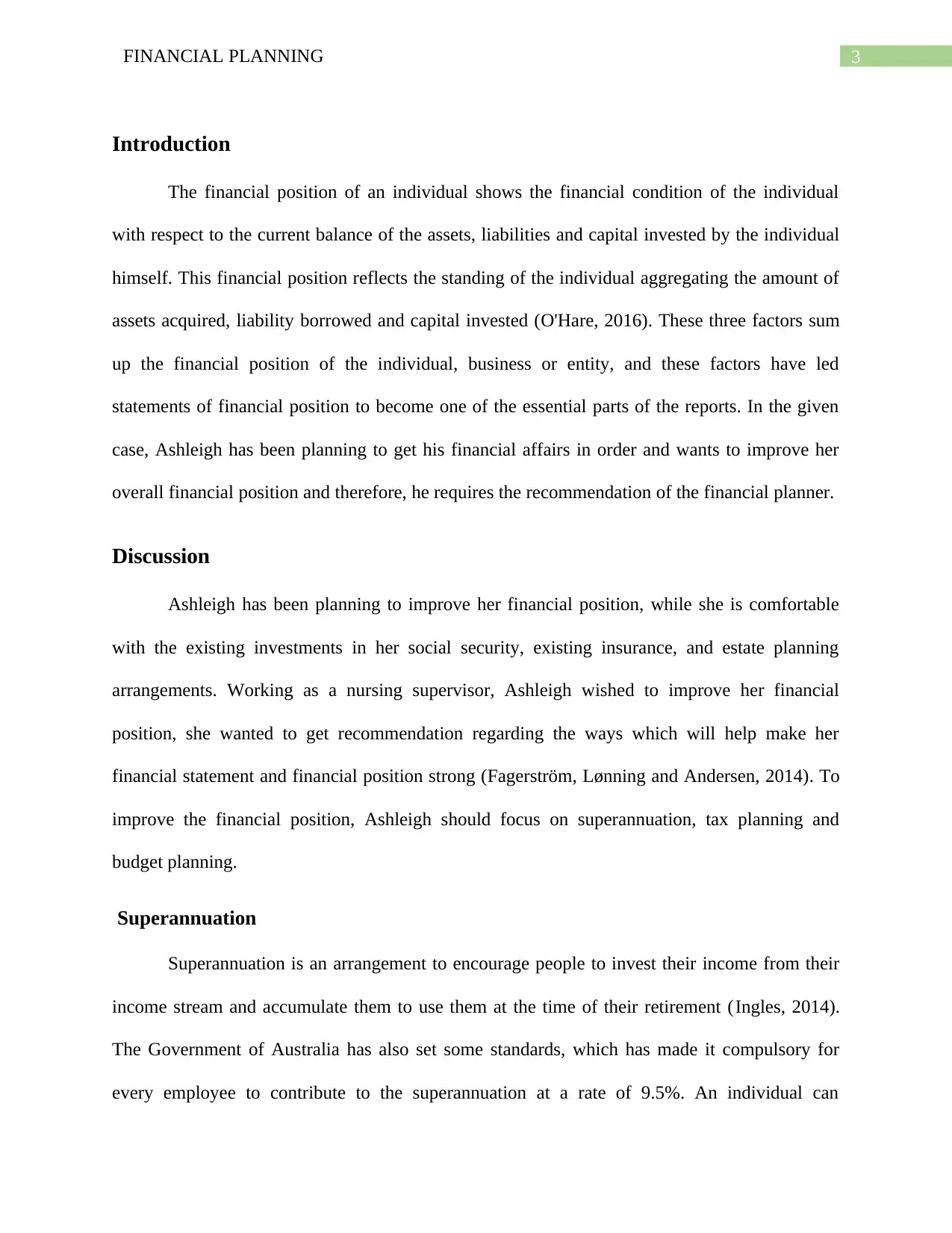
3FINANCIAL PLANNING
Introduction
The financial position of an individual shows the financial condition of the individual
with respect to the current balance of the assets, liabilities and capital invested by the individual
himself. This financial position reflects the standing of the individual aggregating the amount of
assets acquired, liability borrowed and capital invested (O'Hare, 2016). These three factors sum
up the financial position of the individual, business or entity, and these factors have led
statements of financial position to become one of the essential parts of the reports. In the given
case, Ashleigh has been planning to get his financial affairs in order and wants to improve her
overall financial position and therefore, he requires the recommendation of the financial planner.
Discussion
Ashleigh has been planning to improve her financial position, while she is comfortable
with the existing investments in her social security, existing insurance, and estate planning
arrangements. Working as a nursing supervisor, Ashleigh wished to improve her financial
position, she wanted to get recommendation regarding the ways which will help make her
financial statement and financial position strong (Fagerström, Lønning and Andersen, 2014). To
improve the financial position, Ashleigh should focus on superannuation, tax planning and
budget planning.
Superannuation
Superannuation is an arrangement to encourage people to invest their income from their
income stream and accumulate them to use them at the time of their retirement (Ingles, 2014).
The Government of Australia has also set some standards, which has made it compulsory for
every employee to contribute to the superannuation at a rate of 9.5%. An individual can
Introduction
The financial position of an individual shows the financial condition of the individual
with respect to the current balance of the assets, liabilities and capital invested by the individual
himself. This financial position reflects the standing of the individual aggregating the amount of
assets acquired, liability borrowed and capital invested (O'Hare, 2016). These three factors sum
up the financial position of the individual, business or entity, and these factors have led
statements of financial position to become one of the essential parts of the reports. In the given
case, Ashleigh has been planning to get his financial affairs in order and wants to improve her
overall financial position and therefore, he requires the recommendation of the financial planner.
Discussion
Ashleigh has been planning to improve her financial position, while she is comfortable
with the existing investments in her social security, existing insurance, and estate planning
arrangements. Working as a nursing supervisor, Ashleigh wished to improve her financial
position, she wanted to get recommendation regarding the ways which will help make her
financial statement and financial position strong (Fagerström, Lønning and Andersen, 2014). To
improve the financial position, Ashleigh should focus on superannuation, tax planning and
budget planning.
Superannuation
Superannuation is an arrangement to encourage people to invest their income from their
income stream and accumulate them to use them at the time of their retirement (Ingles, 2014).
The Government of Australia has also set some standards, which has made it compulsory for
every employee to contribute to the superannuation at a rate of 9.5%. An individual can
⊘ This is a preview!⊘
Do you want full access?
Subscribe today to unlock all pages.

Trusted by 1+ million students worldwide
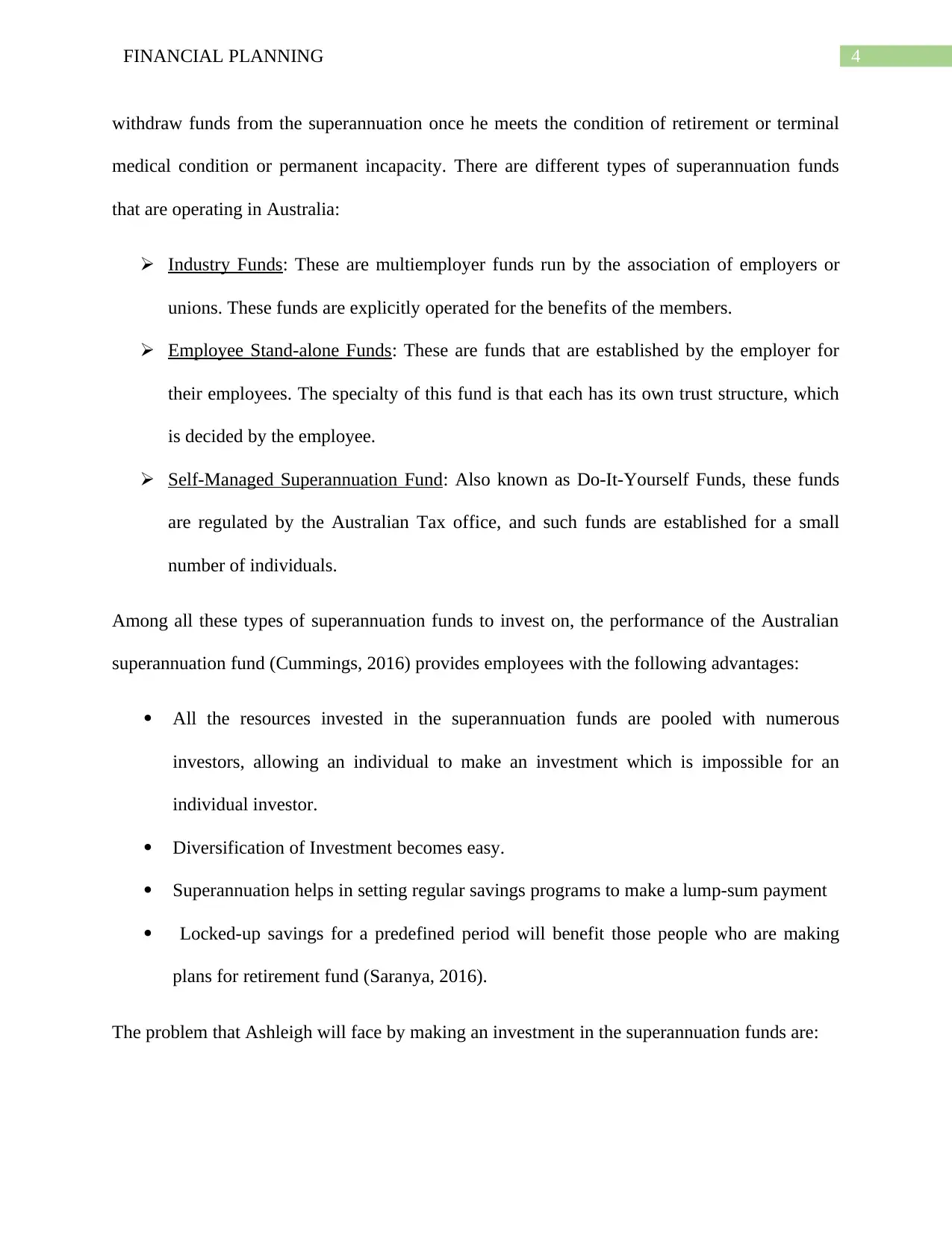
4FINANCIAL PLANNING
withdraw funds from the superannuation once he meets the condition of retirement or terminal
medical condition or permanent incapacity. There are different types of superannuation funds
that are operating in Australia:
Industry Funds: These are multiemployer funds run by the association of employers or
unions. These funds are explicitly operated for the benefits of the members.
Employee Stand-alone Funds: These are funds that are established by the employer for
their employees. The specialty of this fund is that each has its own trust structure, which
is decided by the employee.
Self-Managed Superannuation Fund: Also known as Do-It-Yourself Funds, these funds
are regulated by the Australian Tax office, and such funds are established for a small
number of individuals.
Among all these types of superannuation funds to invest on, the performance of the Australian
superannuation fund (Cummings, 2016) provides employees with the following advantages:
All the resources invested in the superannuation funds are pooled with numerous
investors, allowing an individual to make an investment which is impossible for an
individual investor.
Diversification of Investment becomes easy.
Superannuation helps in setting regular savings programs to make a lump-sum payment
Locked-up savings for a predefined period will benefit those people who are making
plans for retirement fund (Saranya, 2016).
The problem that Ashleigh will face by making an investment in the superannuation funds are:
withdraw funds from the superannuation once he meets the condition of retirement or terminal
medical condition or permanent incapacity. There are different types of superannuation funds
that are operating in Australia:
Industry Funds: These are multiemployer funds run by the association of employers or
unions. These funds are explicitly operated for the benefits of the members.
Employee Stand-alone Funds: These are funds that are established by the employer for
their employees. The specialty of this fund is that each has its own trust structure, which
is decided by the employee.
Self-Managed Superannuation Fund: Also known as Do-It-Yourself Funds, these funds
are regulated by the Australian Tax office, and such funds are established for a small
number of individuals.
Among all these types of superannuation funds to invest on, the performance of the Australian
superannuation fund (Cummings, 2016) provides employees with the following advantages:
All the resources invested in the superannuation funds are pooled with numerous
investors, allowing an individual to make an investment which is impossible for an
individual investor.
Diversification of Investment becomes easy.
Superannuation helps in setting regular savings programs to make a lump-sum payment
Locked-up savings for a predefined period will benefit those people who are making
plans for retirement fund (Saranya, 2016).
The problem that Ashleigh will face by making an investment in the superannuation funds are:
Paraphrase This Document
Need a fresh take? Get an instant paraphrase of this document with our AI Paraphraser
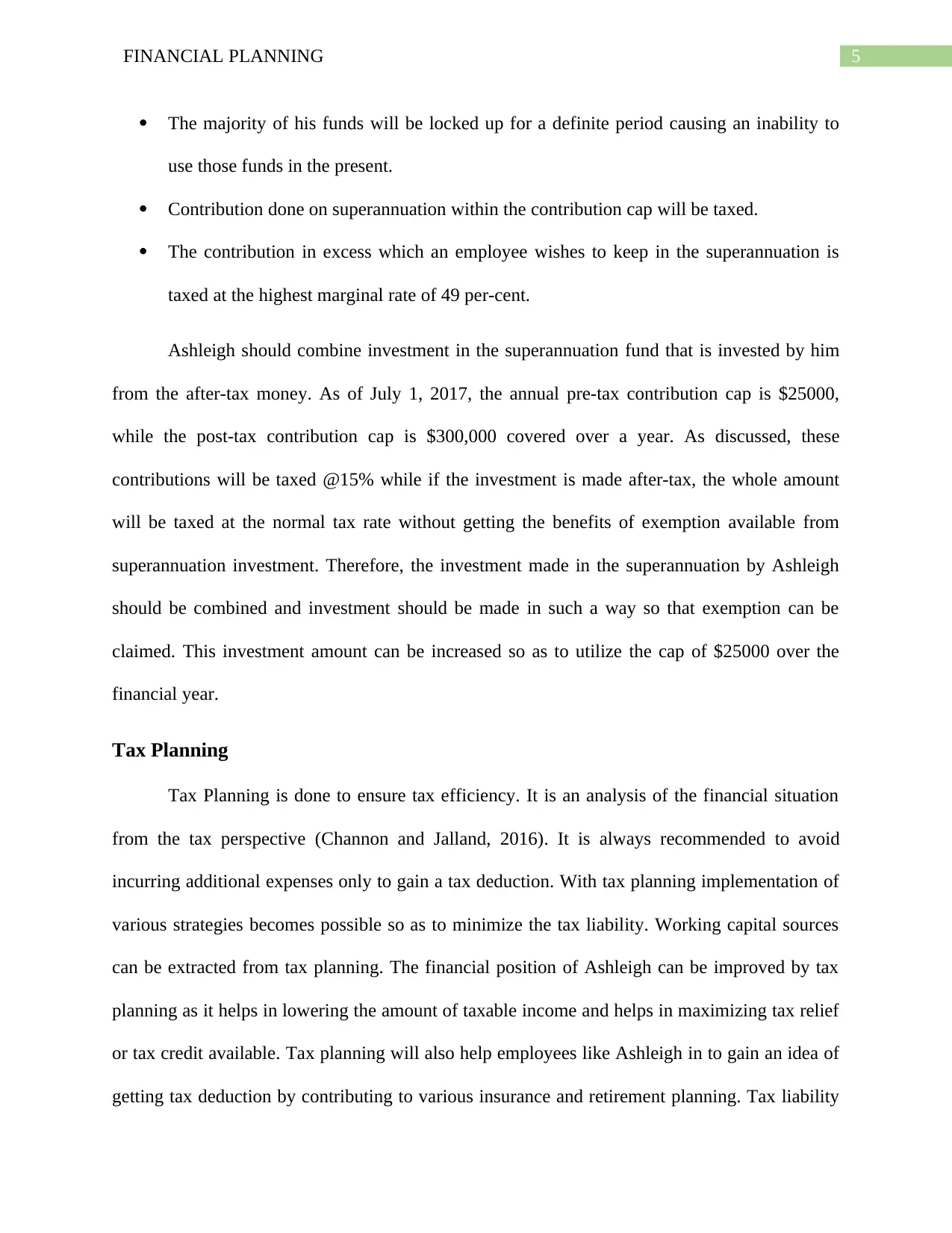
5FINANCIAL PLANNING
The majority of his funds will be locked up for a definite period causing an inability to
use those funds in the present.
Contribution done on superannuation within the contribution cap will be taxed.
The contribution in excess which an employee wishes to keep in the superannuation is
taxed at the highest marginal rate of 49 per-cent.
Ashleigh should combine investment in the superannuation fund that is invested by him
from the after-tax money. As of July 1, 2017, the annual pre-tax contribution cap is $25000,
while the post-tax contribution cap is $300,000 covered over a year. As discussed, these
contributions will be taxed @15% while if the investment is made after-tax, the whole amount
will be taxed at the normal tax rate without getting the benefits of exemption available from
superannuation investment. Therefore, the investment made in the superannuation by Ashleigh
should be combined and investment should be made in such a way so that exemption can be
claimed. This investment amount can be increased so as to utilize the cap of $25000 over the
financial year.
Tax Planning
Tax Planning is done to ensure tax efficiency. It is an analysis of the financial situation
from the tax perspective (Channon and Jalland, 2016). It is always recommended to avoid
incurring additional expenses only to gain a tax deduction. With tax planning implementation of
various strategies becomes possible so as to minimize the tax liability. Working capital sources
can be extracted from tax planning. The financial position of Ashleigh can be improved by tax
planning as it helps in lowering the amount of taxable income and helps in maximizing tax relief
or tax credit available. Tax planning will also help employees like Ashleigh in to gain an idea of
getting tax deduction by contributing to various insurance and retirement planning. Tax liability
The majority of his funds will be locked up for a definite period causing an inability to
use those funds in the present.
Contribution done on superannuation within the contribution cap will be taxed.
The contribution in excess which an employee wishes to keep in the superannuation is
taxed at the highest marginal rate of 49 per-cent.
Ashleigh should combine investment in the superannuation fund that is invested by him
from the after-tax money. As of July 1, 2017, the annual pre-tax contribution cap is $25000,
while the post-tax contribution cap is $300,000 covered over a year. As discussed, these
contributions will be taxed @15% while if the investment is made after-tax, the whole amount
will be taxed at the normal tax rate without getting the benefits of exemption available from
superannuation investment. Therefore, the investment made in the superannuation by Ashleigh
should be combined and investment should be made in such a way so that exemption can be
claimed. This investment amount can be increased so as to utilize the cap of $25000 over the
financial year.
Tax Planning
Tax Planning is done to ensure tax efficiency. It is an analysis of the financial situation
from the tax perspective (Channon and Jalland, 2016). It is always recommended to avoid
incurring additional expenses only to gain a tax deduction. With tax planning implementation of
various strategies becomes possible so as to minimize the tax liability. Working capital sources
can be extracted from tax planning. The financial position of Ashleigh can be improved by tax
planning as it helps in lowering the amount of taxable income and helps in maximizing tax relief
or tax credit available. Tax planning will also help employees like Ashleigh in to gain an idea of
getting tax deduction by contributing to various insurance and retirement planning. Tax liability
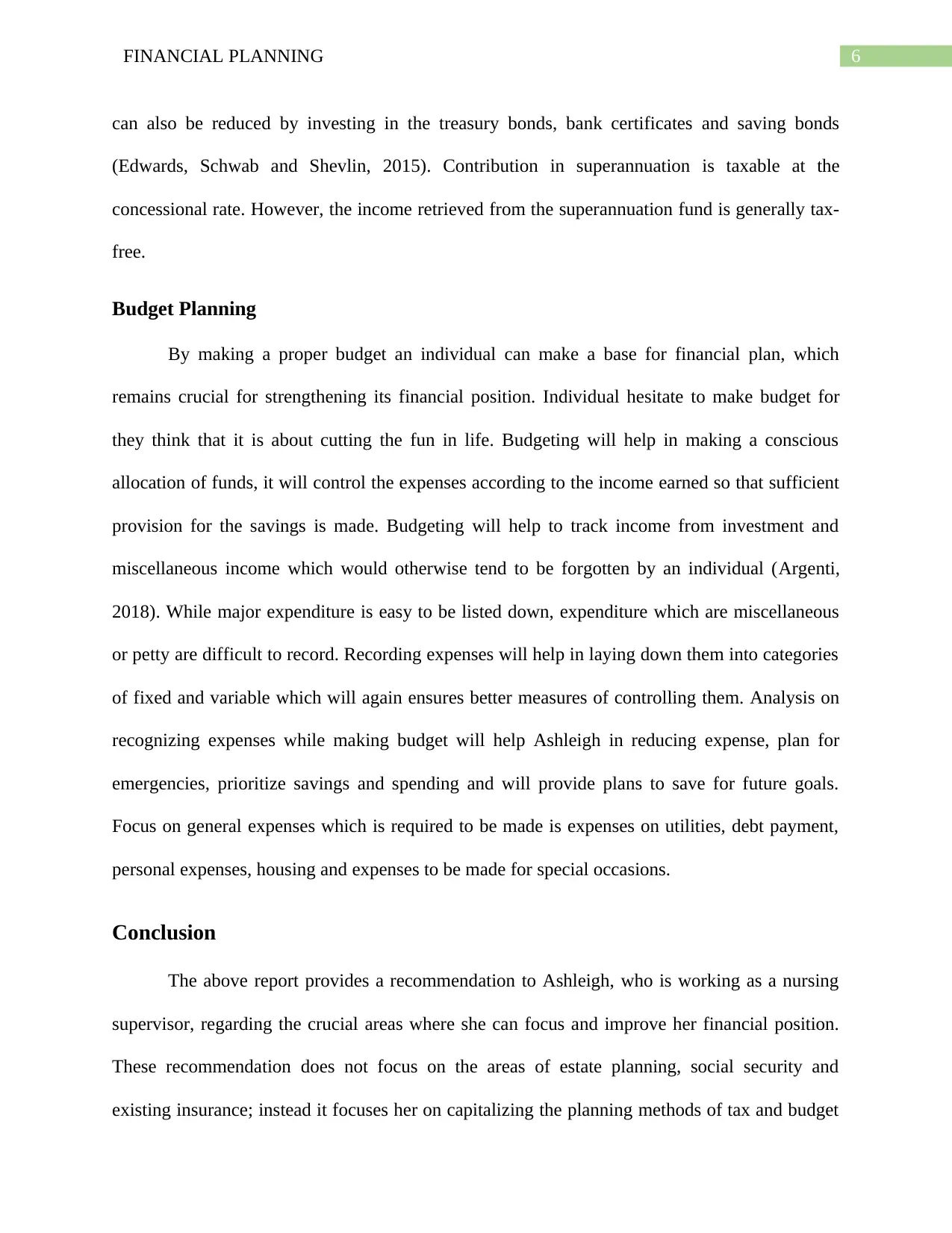
6FINANCIAL PLANNING
can also be reduced by investing in the treasury bonds, bank certificates and saving bonds
(Edwards, Schwab and Shevlin, 2015). Contribution in superannuation is taxable at the
concessional rate. However, the income retrieved from the superannuation fund is generally tax-
free.
Budget Planning
By making a proper budget an individual can make a base for financial plan, which
remains crucial for strengthening its financial position. Individual hesitate to make budget for
they think that it is about cutting the fun in life. Budgeting will help in making a conscious
allocation of funds, it will control the expenses according to the income earned so that sufficient
provision for the savings is made. Budgeting will help to track income from investment and
miscellaneous income which would otherwise tend to be forgotten by an individual (Argenti,
2018). While major expenditure is easy to be listed down, expenditure which are miscellaneous
or petty are difficult to record. Recording expenses will help in laying down them into categories
of fixed and variable which will again ensures better measures of controlling them. Analysis on
recognizing expenses while making budget will help Ashleigh in reducing expense, plan for
emergencies, prioritize savings and spending and will provide plans to save for future goals.
Focus on general expenses which is required to be made is expenses on utilities, debt payment,
personal expenses, housing and expenses to be made for special occasions.
Conclusion
The above report provides a recommendation to Ashleigh, who is working as a nursing
supervisor, regarding the crucial areas where she can focus and improve her financial position.
These recommendation does not focus on the areas of estate planning, social security and
existing insurance; instead it focuses her on capitalizing the planning methods of tax and budget
can also be reduced by investing in the treasury bonds, bank certificates and saving bonds
(Edwards, Schwab and Shevlin, 2015). Contribution in superannuation is taxable at the
concessional rate. However, the income retrieved from the superannuation fund is generally tax-
free.
Budget Planning
By making a proper budget an individual can make a base for financial plan, which
remains crucial for strengthening its financial position. Individual hesitate to make budget for
they think that it is about cutting the fun in life. Budgeting will help in making a conscious
allocation of funds, it will control the expenses according to the income earned so that sufficient
provision for the savings is made. Budgeting will help to track income from investment and
miscellaneous income which would otherwise tend to be forgotten by an individual (Argenti,
2018). While major expenditure is easy to be listed down, expenditure which are miscellaneous
or petty are difficult to record. Recording expenses will help in laying down them into categories
of fixed and variable which will again ensures better measures of controlling them. Analysis on
recognizing expenses while making budget will help Ashleigh in reducing expense, plan for
emergencies, prioritize savings and spending and will provide plans to save for future goals.
Focus on general expenses which is required to be made is expenses on utilities, debt payment,
personal expenses, housing and expenses to be made for special occasions.
Conclusion
The above report provides a recommendation to Ashleigh, who is working as a nursing
supervisor, regarding the crucial areas where she can focus and improve her financial position.
These recommendation does not focus on the areas of estate planning, social security and
existing insurance; instead it focuses her on capitalizing the planning methods of tax and budget
⊘ This is a preview!⊘
Do you want full access?
Subscribe today to unlock all pages.

Trusted by 1+ million students worldwide
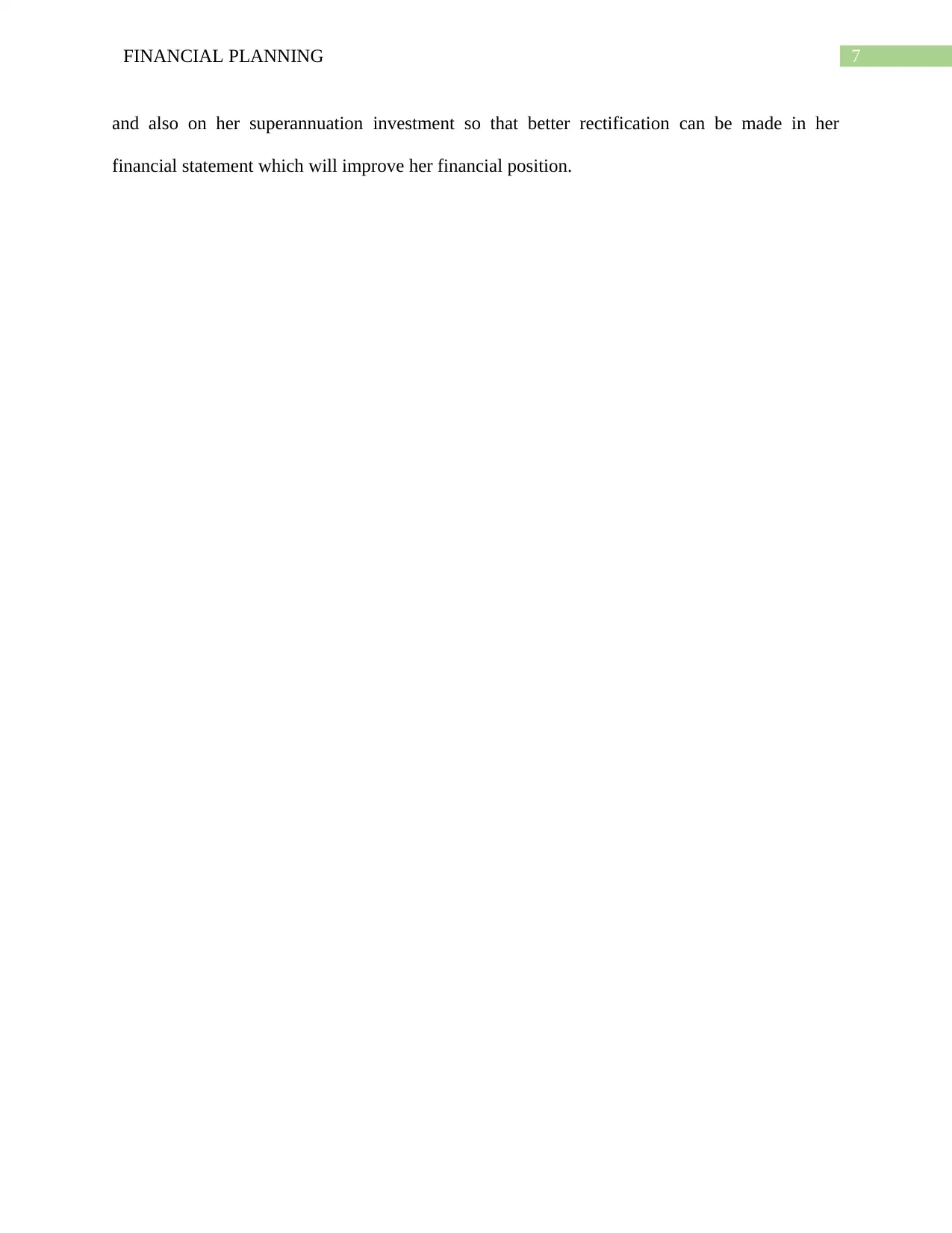
7FINANCIAL PLANNING
and also on her superannuation investment so that better rectification can be made in her
financial statement which will improve her financial position.
and also on her superannuation investment so that better rectification can be made in her
financial statement which will improve her financial position.
Paraphrase This Document
Need a fresh take? Get an instant paraphrase of this document with our AI Paraphraser
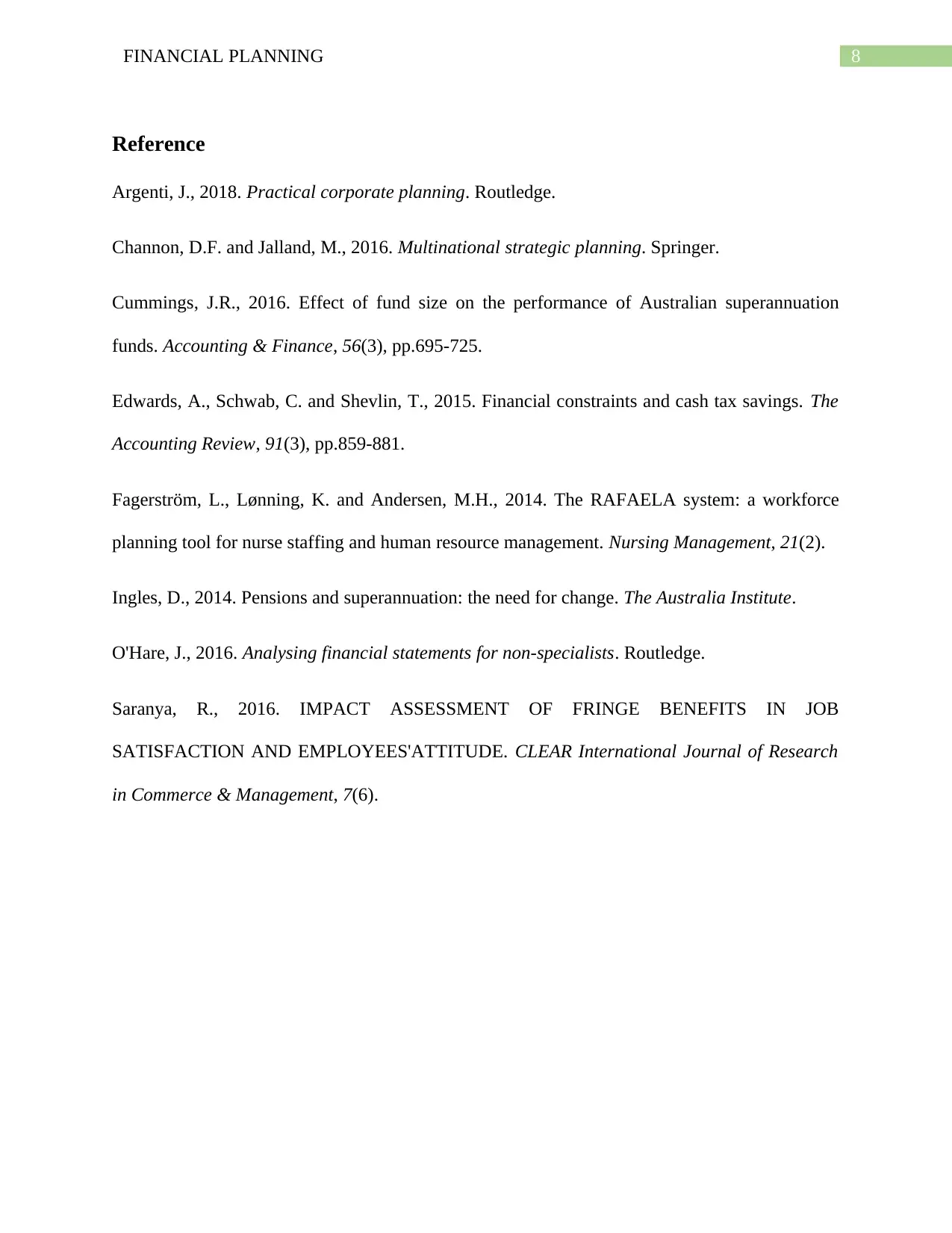
8FINANCIAL PLANNING
Reference
Argenti, J., 2018. Practical corporate planning. Routledge.
Channon, D.F. and Jalland, M., 2016. Multinational strategic planning. Springer.
Cummings, J.R., 2016. Effect of fund size on the performance of Australian superannuation
funds. Accounting & Finance, 56(3), pp.695-725.
Edwards, A., Schwab, C. and Shevlin, T., 2015. Financial constraints and cash tax savings. The
Accounting Review, 91(3), pp.859-881.
Fagerström, L., Lønning, K. and Andersen, M.H., 2014. The RAFAELA system: a workforce
planning tool for nurse staffing and human resource management. Nursing Management, 21(2).
Ingles, D., 2014. Pensions and superannuation: the need for change. The Australia Institute.
O'Hare, J., 2016. Analysing financial statements for non-specialists. Routledge.
Saranya, R., 2016. IMPACT ASSESSMENT OF FRINGE BENEFITS IN JOB
SATISFACTION AND EMPLOYEES'ATTITUDE. CLEAR International Journal of Research
in Commerce & Management, 7(6).
Reference
Argenti, J., 2018. Practical corporate planning. Routledge.
Channon, D.F. and Jalland, M., 2016. Multinational strategic planning. Springer.
Cummings, J.R., 2016. Effect of fund size on the performance of Australian superannuation
funds. Accounting & Finance, 56(3), pp.695-725.
Edwards, A., Schwab, C. and Shevlin, T., 2015. Financial constraints and cash tax savings. The
Accounting Review, 91(3), pp.859-881.
Fagerström, L., Lønning, K. and Andersen, M.H., 2014. The RAFAELA system: a workforce
planning tool for nurse staffing and human resource management. Nursing Management, 21(2).
Ingles, D., 2014. Pensions and superannuation: the need for change. The Australia Institute.
O'Hare, J., 2016. Analysing financial statements for non-specialists. Routledge.
Saranya, R., 2016. IMPACT ASSESSMENT OF FRINGE BENEFITS IN JOB
SATISFACTION AND EMPLOYEES'ATTITUDE. CLEAR International Journal of Research
in Commerce & Management, 7(6).
1 out of 8
Related Documents
Your All-in-One AI-Powered Toolkit for Academic Success.
+13062052269
info@desklib.com
Available 24*7 on WhatsApp / Email
![[object Object]](/_next/static/media/star-bottom.7253800d.svg)
Unlock your academic potential
Copyright © 2020–2025 A2Z Services. All Rights Reserved. Developed and managed by ZUCOL.




